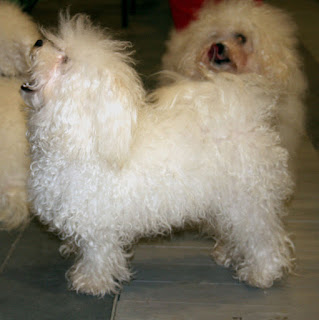The Bolognese is a small breed
of dog of the bichon type, originating in Italy. The name refers to the central
North Italian city of Bologna. It is part of the Toy dog group and is
considered a companion dog. They love attention, and make good house pets. They
are good at socializing with other dogs, big and small. They have a strong bond
with the person/s with whom they spend the most time.
Description
Appearance
The
Bolognese is a small, white, compact dog with a distinctive white single coat.
It is of small size, stocky and compact.[citation needed] It is of square build
and well-muscled. The head is of medium length. The skull is slightly ovoid.
The muzzle is large, black and almost square. It has a developed jaw and the
upper lips don’t cover the bottom lips. Its lips are black. It has white,
strong and evenly aligned teeth. Its eyes are well developed, open and round.
The rims of the eyelids are black and the iris is a dark ochre color. The ears
are set high and are long and hanging but rigid at the base. The tail is
carried curved over the back.
The
Bolognese's height varies 10.5 to 12 inches for a male and 10-11 inches for a female.
The weight varies between 6 and 14 lbs.
Coat
The
distinctive single coat (i.e. no undercoat) falls in loose open ringlets/flocks
all over the body, with shorter hair on the face. The hair's texture is woolly,
as opposed to silky, and is never trimmed or clipped unless kept as pets. The
hair sheds very little, but requires regular combing to prevent matting.
The
Bolognese often appears on lists of dogs that allegedly do not shed (moult). It
is true that these dogs do not seasonally moult or lose large amounts of fur as
many other breeds do. However, they do eventually lose and replace individual
hairs, similar to human hair growth cycles. Each hair grows from a hair
follicle, which has a three phase cycle, as do most mammals. These cycles are:
anagen, growth of normal hair; catagen growth slows, and hair shaft thins;
telegen, hair growth stops, follicle rests, and old hair fall off—is shed. At
the end of the telegen phase, the follicle begins the cycle again. The length
of time of the growing and shedding cycle varies by age and other factors.
There is no such thing as a completely non-shedding breed.
The
coat requires daily brushing with monthly grooming recommended. Grooming must
also include regular bathing, eye and ear hygiene and teeth cleaning
Temperament
Characteristic
traits of the Bolognese include: playful, easygoing, earnest, willing,
intelligent and loyal. They are not hyperactive and are normally more reserved
than the Bichon Frise.
The
Bolognese is very responsive to obedience training.They are
highly intelligent, quick to learn, and easy to train, but can be very stubborn
when they don’t get their way.[citation needed] A Bolognese will quickly train
to potty pads and a bell-ringing notification system for taking potty breaks
outside.
The
Bolognese genuinely enjoys the companionship of people and forms a close
relationship with his owner.They are true companions and thrive on their
owner’s attention. They have been known to follow their owners wherever they
go. They are friendly with strangers but need to get accustomed to people at a
young age. They can be reserved with strangers at first, but the response of
the owners to the new person greatly influences their behavior towards the
individual. Because of this, they are generally friendly towards strangers
after the initial meeting. Bolognese are true watchdogs, but are not incessant
barkers. They will notice anything unusual and dependably notify their owners.
Bolognese get along well with other dogs but are happy to be the only dog in
the family. They are non-aggressive by nature.
They
do not do well when left alone for long period of time and may develop separation
anxiety.
Ideal
owners of Bolognese include families with children, retirees, and city
dwellers. They are good with children as long as the latter are old enough and
mature enough to handle these dogs gently, carefully, and safely. They are not
a good choice for younger children who could easily injure small dogs.
Activities
Exercise
While
Bolognese are perfectly happy to lounge around the house, they should also have
a daily walk. A suitable walk would be around 20–25 minute a couple of times a
day or substitute 10-minute walks a few times a day.
Training
Bolognese
are easy to train but soon become bored by numerous repetitive drills. They
thrive on variety so it is best to change or expand activities to keep them
happily engaged and thinking. They respond well to positive reinforcement,
gentle training methods and consistency. They do not respond well to shouting
or harshness.
Health
Life span
The
average life span of the Bolognese is 14 years. They can live up to 10 years
with relatively few genetic health issues. They are known to still act
puppy-like at 10 years of age and are able to maintain aspects of youthfulness
throughout their lives. They are typically active well into their senior years.
Common health problems






Thank you so much for sharing such a nice post. Indeed, the Bolognese dog is one of the most affectionate and loyal breeds not only to his owner but to everyone he meets.
ReplyDelete